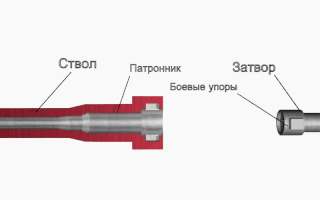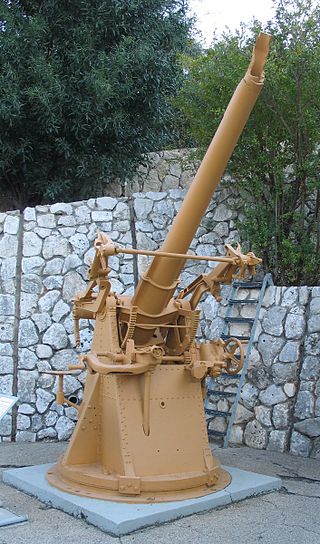
A firearm is any type of gun that uses an explosive charge and is designed to be readily carried and used by an individual. The term is legally defined further in different countries.

Gun safety is the study and practice of using, transporting, storing and disposing of firearms and ammunition, including the training of gun users, the design of weapons, and formal and informal regulation of gun production, distribution, and usage, for the purpose of avoiding unintentional injury, illness, or death. This includes mishaps like accidental discharge, negligent discharge, and firearm malfunctions, as well as secondary risks like hearing loss, lead poisoning from bullets, and pollution from other hazardous materials in propellants and cartridges. There were 47,000 unintentional firearm deaths worldwide in 2013.

A chain gun is a type of autocannon or machine gun that uses an external source of power to cycle the weapon's action via a continuous loop of chain similar to that used on a motorcycle or bicycle, instead of diverting excess energy from the cartridges' propellant as in a typical automatic firearm.

Hang fire is an unexpected delay between the triggering of a firearm and the ignition of the propellant. This failure was common in firearm actions that relied on open primer pans, due to the poor or inconsistent quality of the powder, although modern firearms are also susceptible. The delay is usually too brief to be noticed, but can be several seconds. A hangfire should be suspected whenever a firearm fails to fire, but has not clearly malfunctioned.

In breechloading firearms, an extractor is an action component that serves to remove spent casings of previously fired cartridges from the chamber, in order to vacate the chamber for loading a fresh round of ammunition.
Tap, rack, bang (TRB) or tap, rack, and go (TRG) is jargon for the response to a failure to fire in a firearm with a removable magazine. This is designated as an "Immediate Action" and involves no investigation of the cause, but is effective for common failures, such as defective or improperly seated ammunition magazines.
- Tap – to tap the magazine. This is to ensure that the magazine is properly/completely inserted in the firearm so that it feeds properly. As typically taught in tactical firearms courses, the "tap" is applying pressure on the floor plate of the magazine to lock it into place. It does not constitute 'smacking' the magazine, as this can irreversibly damage the magazine's lip.
- Rack – pull back sharply and then quickly release the cocking handle/slide of the firearm. This will eject a misfired round, which could be a possible cause of the stoppage, and to chamber the next round.
- Bang/Go – aiming and firing the firearm again. If the firearm again does not fire or fails to extract the spent round, it may indicate a more serious problem with the firearm, requiring maintenance. For instance, if the firing pin is too lightly striking the primer on a cartridge, it may indicate a worn-out spring or firing pin.

A trigger is a mechanism that actuates the function of a ranged weapon such as a firearm, airgun, crossbow, or speargun. The word may also be used to describe a switch that initiates the operation of other non-shooting devices such as a trap, a power tool, or a quick release. A small amount of energy applied to the trigger leads to the release of much more energy.

A slamfire is a discharge of a firearm occurring as a cartridge is being loaded into the chamber. Some firearms are designed to slamfire, but the term also describes a malfunction of self-loading firearms. Shooters accustomed to firearms requiring trigger activation for discharge may be unprepared for a slamfire discharge.

Optimus Prime, also known in Japan as Convoy, is a fictional character and the protagonist of the Transformers franchise. Generally depicted as a brave and noble leader, Optimus Prime is the supreme commander of the Autobots in their fight against the Decepticons. The Transformers characters were developed for an American market after Hasbro representatives visited the 1983 Tokyo Toy Show. The characters were modified and the coloring was changed; notably, Optimus Prime was colored red, chrome, and dark blue. The popularity of the Transformers toys resulted in comics, movies, and even a TV series.

Capacitor discharge ignition (CDI) or thyristor ignition is a type of automotive electronic ignition system which is widely used in outboard motors, motorcycles, lawn mowers, chainsaws, small engines, turbine-powered aircraft, and some cars. It was originally developed to overcome the long charging times associated with high inductance coils used in inductive discharge ignition (IDI) systems, making the ignition system more suitable for high engine speeds. The capacitive-discharge ignition uses capacitor to discharge current to the ignition coil to fire the spark plugs.

A squib load, also known as a squib round, pop and no kick, or just a squib, is a firearm malfunction in which a fired projectile does not have enough force behind it to exit the barrel, and thus becomes stuck. This type of malfunction can be extremely dangerous, as failing to notice that the projectile has become stuck in the barrel may result in another round being fired directly into the obstructed barrel, resulting in a catastrophic failure of the weapon's structural integrity.
Forward assisting is the practice of moving the bolt or bolt carrier of a firearm fully forward in battery when the return spring has not done so to prevent out-of-battery firing. It is only used on closed bolt only firearms. Some firearms have a dedicated device to allow forward assisting; on others, it is simply a procedure performed on reciprocating charging handles.

Saab Direct Ignition is a capacitor discharge ignition developed by Saab Automobile, then known as Saab-Scania, and Mecel AB during the 1980s.
A firearm malfunction is the failure of a firearm to operate as intended for causes other than user error. Malfunctions range from temporary and relatively safe situations, such as a casing that did not eject, to potentially dangerous occurrences that may permanently damage the gun and cause injury or death. Improper handling of certain types of malfunctions can be very dangerous. Following gun safety rules can prevent firearm malfunctions, and limit the damage inflicted by them if they do occur. Proper cleaning and maintenance of a firearm play a big role in preventing malfunctions.

Firearm maintenance is a series of routine preventive maintenance procedures aiming to ensure the proper function of a firearm, often with the use of a variety of specialized tools and chemical solutions. Typically such maintenance is performed by the firearm owner using either simple methods such as cleaning the firearm with oil or other cleaning solutions or more sophisticated practices such as lubricating moving parts with oil/grease and recoating exposed surfaces with protective finishes such as varnishing or bluing.

In firearms, a safety or safety catch is a mechanism used to help prevent the accidental discharge of a firearm, helping to ensure safer handling.
The FN FNS pistol is a series of striker-fired semi-automatic, polymer-framed pistols manufactured in Fredericksburg, Virginia, by FN America, a division of Fabrique Nationale Herstal. The pistol is chambered for the 9×19mm Parabellum and .40 S&W cartridges.
An unintentional discharge is the event of a firearm discharging (firing) at a time not intended by the user. An unintended discharge may be produced by an incompatibility between firearm design and usage, such as the phenomenon of cooking off a round in a closed bolt machine gun, a mechanical malfunction as in the case of slamfire in an automatic weapon, or be user induced due to training issues or negligence. The phenomenon has also been defined in scientific literature as an activation of the trigger mechanism that results in an unplanned discharge that is outside of the firearm’s prescribed use, where "prescribed use" refers to departmental policies and laws related to the operation of firearms.

The SIG Sauer P320 is a modular semi-automatic pistol made by SIG Sauer, Inc., SIG Sauer's American branch. It is a further development of the SIG Sauer P250, utilizing a striker-fired mechanism in lieu of a double action only hammer system. The P320 can be chambered in 9×19mm Parabellum, .357 SIG, .40 S&W, .45 ACP, and 10mm Auto and can be easily converted from one caliber to another; a change from .357 SIG to .40 S&W requires only a barrel change; a change from 9mm to .357 SIG or .40 S&W is accomplished using a caliber exchange kit.













